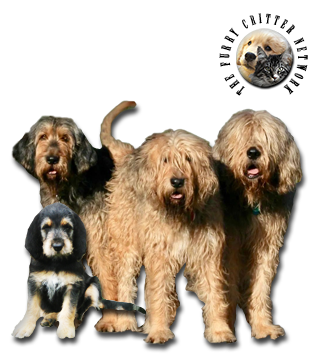Breed Standard
Head: Taller than it is wide. Well-domed skull. Stop not pronounced. Strong, high-set muzzle. Abundant flews. Slight beard and mustache. Strong, large jaws.
Ears: Long and pendulous, with feathering and a characteristic fold. Front edge folded or rolled inward.
Eyes: Color depends on coat color.
Body: Solid. Long, powerful neck. Chest well let-down.
Tail: Thick at the base, tapering toward the tip. Carried high in action.
Hair: 4 to 8 cm long, dense, thick, hard, and waterproof. Oily, woolly undercoat.
Coat: All recognized hound colors allowed: whole-colored, grizzled, sable, red, wheaten, and blue. May have slight white markings on the head, chest, feet, and tip of the tail. White dogs may have slight lemon, blue, or badger grey markings.
Size: Dog: approx. 67 cm. Bitch: approx. 60 cm.
Weight: approx. 32 kg.
History
This large, shaggy breed is believed to be descended from the Saint Hubert Hound and French griffons (the Griffon Vend e and the Griffon Nivernais) imported to England before 1870 after receiving Harrier and Wirehaired Terrier blood. Otterhounds were developed to hunt otter, pursuing it even underwater. It is one of the ancestral breeds of the Airedale Terrier.
Otter hunting dates back to the early medieval period, with references it is found as early as 1360. The otterhound, however, can only be traced back as a distinct breed as far as the early 1800s.
The otter is one of the largest and most intelligent carnivorous mammals in Europe. To be equal to the otter, an Otterhound was said to need "a Bulldog's courage, a Newfoundland's strength in water, a Pointer's nose, a Retriever's sagacity, the stamina of a Foxhound, the patience of a Beagle, and the intelligence of a Collie".
In 1978, due to the dramatic decline in otter numbers, the otter was placed on the list of protected species in Britain, and otter hunting therefore ceased. It was never banned in Britain, the otter hunts stopped hunting voluntarily, as it was they who realised that otter numbers were dropping dramatically and brought it to the attention of the authorities. By 1977, nine registered packs of otterhounds were still in existence. A few hunts switched to hunting mink or coypu, but many of the original otterhound packs ceased to exist altogether. Hounds were often passed to newly founded minkhound packs. The Pembroke and Carmarthenshire Minkhounds are the only pack today with a pure otterhound pack. As the dogs had been selectively bred for their hunting capabilities, only a few of the bloodlines were suitable for breeding into companion animals.
Behavior
Otterhounds are courageous, tenacious, and stubborn. They are very resistant to cold, love water, and are excellent swimmers. They can spend an entire day hunting in the water but can also gallop about on dry land. Kind, even-tempered, affectionate, and playful, they make wonderful companions. Otterhounds require firm training.
Function
Otterhounds need lots of exercise and weekly brushing. Being a hunting dog, special attention should be given to the ears.
Health
The Otterhound enjoys considerable exercise, but can also be a couch potato. They can be good family dogs but need to be kept in a secure property since they can jump fences up to 5 feet high, but rarely try.
In spite of the small gene pool, the Otterhound is generally a healthy breed, but is subject to many of the same complaints as all large, rapidly growing dogs.
Common problems that can occur are elbow and hip dysplasia, a malformation of the elbow and hip joints. These are not always painful, but can cause lameness and impair mobility, and result in arthritis. Badly affected hounds should not be bred from, but most Otterhounds have a poor hip and elbow score. The problem can be reduced by making sure that young Otterhounds do not jump down from high places, go up and down the stairs or walk too much on very hard surfaces while bones are still growing. This enables the muscles around the sockets to strengthen and develop, providing more support.
Otterhounds have a predisposition to ear problems (as can any breed with this type of ear) and a predisposition to gastric dilatation volvulus (bloat), due to their deep chest.
Epilepsy and seizures are also known to affect the breed, and can be hereditary. There is ongoing research into the causes of epilepsy in Otterhounds. For reasons currently unknown, epilepsy in Otterhounds in the United States does not appear to be fatal, while epilepsy found Otterhounds from the United Kingdom is frequently untreatable, and is usually fatal.






